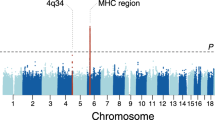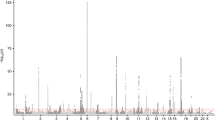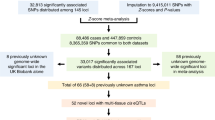Abstract
Lung epithelium plays a central role in modulation of the lung inflammatory response, and lung repair and airway epithelial cells are targets in asthma and viral infection. Activated T lymphocytes release cytokines such as interferon-gamma (IFN-γ) that induce apoptosis, or programmed cell death, of damaged epithelial cells. Death-associated protein-3 (DAP3) is involved in mediating IFN-γ-induced cell death. To assess the possible involvement of genetic variants of DAP3 with asthma, we searched for single-nucleotide polymorphisms (SNPs) in the gene and conducted a case-control study with 1,341 subjects. We found a strong association between bronchial asthma (BA) in adults (P=0.0051, odds ratio=1.87, 95% CI=1.20–2.92), whereas no association was found with childhood asthma. The tendency was more prominent in patients with higher serum total immunoglobulin E (IgE) (>250 IU/ml) (P=0.00061, odds ratio=2.40, 95% CI=1.44–4.00). DAP3 was expressed in normal bronchial epithelial cells, and the expression was induced by IFN-γ. These results indicated that specific variants of the DAP3 gene might be associated with the mechanisms responsible for adult BA and contribute to airway inflammation and remodeling.
Similar content being viewed by others
Introduction
Bronchial asthma (BA) is a complex disorder caused by a combination of genetic and environmental factors (Busse and Lemanske 2001). In recent years, a growing body of clinical and experimental evidence has highlighted the importance of respiratory infections in acute asthma exacerbation (Gern and Busse 2002; Message and Johnston 2001). Most infections induce asthma exacerbation and a T helper (Th) 1 inflammatory response. Some studies have shown that some Th1 cells are present in asthmatic patients, which could be related to bronchial hyperreactivity (Krug et al. 1996; Magnan et al. 2000; Cho et al. 2002). Interferon-γ (IFN-γ), produced by Th1 cells, exerts an inhibitory effect on Th2 cells and has extensive and diverse immunoregulatory effects on various cells (Chung and Barnes 1999). A recent study showed that IFN-γ alone and in combination with activation of the Fas pathway induced apoptosis, or programmed cell death, in A549 lung epithelial cells (Wen et al. 1997). Disruption of the bronchial epithelium is frequently observed in mucosal biopsies obtained from asthmatic airways (Laitinen et al. 1985; Jeffery et al. 1989; Montefort et al. 1992).
Apoptosis plays crucial roles in numerous biological processes ranging from growth and development to combating viral infections. Human DAP3 was originally isolated as a novel mediator of IFN-γ-induced cell death by performing functional selection by gene cloning. The gene codes for a 46 kDa protein with a potential nucleotide-binding motif (Kissil et al. 1995). Functional analyses of the protein indicate that the intact full-length protein is required for its ability to induce apoptosis when overexpressed, and DAP3 is implicated as a positive mediator of tumor necrosis factor α (TNF-α) and Fas (Kissil et al. 1999). Furthermore, genome screens for asthma and related phenotypes have been completed in 11 study populations. The human DAP3 gene lies on chromosome 1q21–q22 (Kissil and Kimchi 1997), a locus linked to atopy susceptibility (Ober et al. 1999). To investigate the possible involvement of variants of DAP3 with asthma in humans, we searched for single-nucleotide polymorphisms (SNPs) in the gene and conducted a genetic association study in Japanese.
Materials and methods
Subjects
We recruited 305 patients with child atopic asthma [mean age 9.6, range 1–15 years; male/female ratio=1.54:1.0; mean serum immunoglobulin E (IgE) level, 1,083 U/ml], 322 with adult atopic asthma (mean age 49, range 20–91 years; male/female ratio=1.0:1.18; mean serum IgE level, 762.8 U/ml), and 95 with adult nonatopic asthma (mean age 60, range 42–80 years; male/female ratio=1.0:1.71; mean serum IgE level, 152.5 U/ml) from Osaka Prefectural Habikino Hospital and the Miyatake Asthma Clinic.. All subjects with asthma were diagnosed according to the criteria of the National Institutes of Health, with minor modifications (National Heart, Lung, and Blood Institute, National Institutes of Health, 1997). The diagnosis of atopic asthma was based on a positive immunoassay test to one or more allergens or total serum IgE level of ≥400 kU/l. The criteria for a diagnosis of nonatopic asthma were a total serum IgE level of <400kU/l and all allergen-specific IgE level of ≤0.35 kU/l (Mao et al. 2001). As controls, we analyzed 571 randomly selected population-based individuals who did not have atopy-related diseases (mean age 36, range 18–83 years; male/female ratio=2.42:1.0). All individuals were Japanese and gave written informed consent to participate in the study (or, for individuals younger than 16 years old, their parents gave consent) in accord with the rules of the process committee at the SNP Research Center, The Institute of Physical and Chemical Research (RIKEN).
Screening for polymorphisms and genotyping
The DAP3 genomic region targeted for SNP discovery included a 0.5 kb continuous region 5′ to the gene and 13 exons, each with a minimum of 200 bases of a flanking intronic sequence. Twelve primer sets (Table 1) were designed on the basis of the DAP3 genomic sequence available from GenBank (accession number NT_079484). Each polymerase chain reaction (PCR) was performed with 5 ng of genomic DNA from 24 individuals. The PCR product was reacted with BigDye Terminator v3.1 (Applied Biosystems, Foster City, CA, USA). Sequences were assembled, and polymorphisms were identified using the Sequencher program (Gene Codes Corporation, Ann Arbor, MI, USA).
Genotyping
For the −20632 G/T polymorphism, genotyping was performed by PCR-restriction fragment-length polymorphism (PCR-RFLP) analysis using EcoT14I (Takara, Shiga, Japan). The primers for the SNP were 5′TCAGGACGGGCGCTTTGTG and 5′GGTCTACCGGCCTCACT.
Statistical analysis
Allele frequencies for each SNP were calculated. A χ 2 goodness-of-fit test was used to assess deviation from Hardy–Weinberg equilibrium for genotype frequencies at each locus. Associations of genotypes or alleles with patient groups versus nonatopic control subjects were determined by using χ 2 analysis with appropriate df.
Quantitative real-time PCR
Human bronchial epithelial cells (NHBE) were purchased from BioWhittaker, and human recombinant IFN-γ was purchased from Genzyme/Techne. Total RNA (5 μg) extracted from each sample was treated with DNaseI (Roche), and cDNA was synthesized with Thermoscript reverse transcriptase (Life Technologies) by dT15 priming. TaqMan probes and primers for DAP3 and GAPDH were Assay-on-Demand gene expression products (Applied Biosystems). TaqMan PCR was done with an ABI PRISM 7900 Sequence Detection System (Applied Biosystems) according to the manufacturer’s instructions. The relative expression of DAP3 mRNA was normalized to the amount of GAPDH in the same cDNA by using the standard curve method described by the manufacturer.
Tissue expression
We used human multiple tissue, human immune system, and human blood fractions multiple tissues cDNA panels from CLONTECH for expression analysis by PCR amplification of target sequences. The primers for DAP3 were 5′GCACTTGTTCACAACTTGAG and 5′TCTGTAGGAGCTTTCTCATG. The primers for GAPDH were 5′CCCCATGTTCGTCATGGGT and 5′GTGATGGCATGGACTGTGG. Southern blotting was done with DIG reagents and kits for nonradioactive nucleic acid labeling and detection (Roche) according to the manufacturer’s instructions. The probes for DAP3 and GAPDH were 5′AAATGATTGGCATGGAGGCG and 5′CCATGAGAAGTATGACAACAG, respectively.
Results
An extensive search identified four SNPs by PCR-directed sequencing using genomic DNA from 24 individuals on the basis of the DAP3 genomic sequence. Position one was the adenine of the initiation codon. These were −20632 G/T, 15900 A/G, 21573 A/G, and 27657 G/C (Fig. 1, Table 2). The 15900 A/G (IMS-JST084352) and 21573 A/G (IMS-JST070763) are contained in the J-SNPs that are available from the Web site (http://snp.ims.u-tokyo.ac.jp). Since three of the SNPs were quite rare, further case-control analysis focused on −20632 G/T, which was located in the 5′ noncoding region of DAP3. We found a strong association between −20632 G/T and BA in adults (P=0.0051, odds ratio=1.87, 95% CI=1.20–2.92), whereas no association was found with childhood asthma (Table 3). The tendency was more prominent in patients with higher serum total IgE (>250 IU/ml) (P=0.00061, odds ratio=2.40, 95% CI=1.44–4.00) (Table 4).
We investigated DAP3 expression of cultured NHBE by RT-PCR, and DAP3 was expressed in NHBE (data not shown). Next we compared relative expression of DAP3 in NHBE that were either unstimulated or stimulated with 10 ng/ml IFN-γ for 3 h. Levels of DAP3 mRNA were increased 10.6 fold by stimulation with IFN-γ (Fig. 2).
We performed RT-PCR using multiple tissue cDNA panels. Transcripts were expressed in lung and tissues and cells associated with immune function. The bands were present in both cDNAs from activated and inactivated lymphocytes (Fig. 3).
Discussion
Asthma is an inflammatory airway disease associated with infiltration of T cells and eosinophils, increased levels of proinflammatory cytokines, and shedding of bronchial cells (Busse and Lemanske 2001), which is an important histologic feature observed in bronchial biopsy specimens from asthmatic patients (Laitinen et al. 1985; Jeffery et al. 1989; Montefort et al. 1992). A recent study demonstrated that both T cells and eosinophils contribute to the induction of bronchial epithelial cell apoptosis by secretion of IFN-γ and TNF-α (Trautmann et al. 2002). Although we could not show functional data on this SNP in this study, we found that DAP3 was expressed in NHBE, and the transcript was induced by IFN-γ. DAP3, a positive mediator of cell death induced by IFN-γ, may play an important role in the epithelial cell shedding frequently observed in asthma.
In our study, adult BA showed a stronger association with variant −20632 G/T than did childhood BA, especially in patients with high levels of serum IgE. Asthma in adults is often a slowly progressive, irreversible disease (Reed 1999). The majority of older patients have a substantial degree of irreversible impairment of lung function that results from a combination of pathologic changes. These changes include airway remodeling from chronic lymphocytic-eosinophilic inflammation and bronchiectasis from repeated infections. DAP3 mediating IFN-γ-induced cell death might be involved in the development of chronic progressive irreversible inflammation, which is more frequently observed in adult asthma than childhood asthma. A recent report showed that influenza A viral infection, which induces a large amount of intrapulmonary IFN-γ production, enhanced later allergen-specific asthma and promoted dual allergen-specific Th1 and Th2 responses (Dahl et al. 2004). Several studies reported that some Th1 cells were present in asthmatic patients, which could be related to bronchial hyperreactivity (Krug et al. 1996; Magnan et al. 2000; Cho et al. 2002). The epithelial injuries might induce inflammatory reactions and change the mucosal permeability to allow allergens easier access to dendritic cells and enhance subsequent allergen sensitization.
Apoptosis provides a mechanism for removal of antigen-activated T cells and eosinophils, thereby leading to the resolution of the inflammatory response (Haslett 1992; Lenardo et al. 1995; Woolley et al. 1996). The accumulation of eosinophils in the asthmatic airway significantly contributes to the persistence of airway inflammation in these patients (Kroegel et al. 1994). Decreased numbers of eosinophils undergoing apoptosis have been observed in asthmatic subjects when compared with a nonasthmatic control group (Vignola et al. 1999). Although we found that DAP3 was expressed in lung, tissue, and cells associated with immune function and NHBE, the expression profile of DAP3 in eosinophils and antigen-activated T cells remains unclear. Thus, further study is required to clarify the physiological role of DAP3 in these cells.
Apoptosis is an essential process for functions such as the immune response, and glucocorticoids, the most effective treatments for asthma, are one of the important regulators of the cellular functions underlying these events (Walsh et al. 2003). It has been suggested that DAP3 directly interacts with the glucocorticoid receptor (GR), and DAP3 is needed to efficiently increase the GR level and enhance the transcriptional activity of GR (Hulkko et al. 2000; Hulkko and Zilliacus 2002). Dexamethasone has been reported to inhibit lung epithelial cell apoptosis induced by IFN-γ (Wen et al. 1997). Further analyses of genetic predisposition for expression of DAP3 contributing to the pathogenesis of asthma might lead to improved diagnosis, treatment, and prevention.
References
Busse WW, Lemanske RF Jr (2001) Asthma. N Engl J Med 344:350–362
Cho SH, Stanciu LA, Begishivili T, Bates PJ, Holgate ST, Johnston SL (2002) Peripheral blood CD4+ and CD8+ T cell type 1 and type 2 cytokine production in atopic asthmatic and normal subjects. Clin Exp Allergy 32:427–433
Chung KF, Barnes PJ (1999) Cytokines in asthma. Thorax 54:825–857
Dahl ME, Dabbagh K, Liggitt D, Kim S, Lewis DB (2004) Viral-induced T helper type 1 responses enhance allergic disease by effects on lung dendritic cells. Nat Immunol 5:337–343
Gern JE, Busse WW (2002) Relationship of viral infections to wheezing illnesses and asthma. Nat Rev Immunol 2:132–138
Haslett C (1992) Resolution of acute inflammation and the role of apoptosis in the tissue fate of granulocytes. Clin Sci (Lond) 83:639–648
Hulkko SM, Zilliacus J (2002) Functional interaction between the pro-apoptotic DAP3 and the glucocorticoid receptor. Biochem Biophys Res Commun 295:749–755
Hulkko SM, Wakui H, Zilliacus J (2000) The pro-apoptotic protein death-associated protein 3 (DAP3) interacts with the glucocorticoid receptor and affects the receptor function. Biochem J 349:885–893
Jeffery PK, Wardlaw AJ, Nelson FC, Collins JV, Kay AB (1989) Bronchial biopsies in asthma. An ultrastructural, quantitative study and correlation with hyperreactivity. Am Rev Respir Dis 140:1745–1753
Kissil JL, Kimchi A (1997) Assignment of death associated protein 3 (DAP3) to human chromosome 1q21 by in situ hybridization. Cytogenet Cell Genet 77:252
Kissil JL, Deiss LP, Bayewitch M, Raveh T, Khaspekov G, Kimchi A (1995) Isolation of DAP3, a novel mediator of interferon-gamma-induced cell death. J Biol Chem 270:27932–27936
Kissil JL, Cohen O, Raveh T, Kimchi A (1999) Structure-function analysis of an evolutionary conserved protein, DAP3, which mediates TNF-alpha- and Fas-induced cell death. EMBO J 18:353–362
Kroegel C, Virchow JC Jr, Luttmann W, Walker C, Warner JA (1994) Pulmonary immune cells in health and disease: the eosinophil leucocyte (Part I). Eur Respir J 7:519–543
Krug N, Madden J, Redington AE, Lackie P, Djukanovic R, Schauer U, Holgate ST, Frew AJ, Howarth PH (1996) T-cell cytokine profile evaluated at the single cell level in BAL and blood in allergic asthma. Am J Respir Cell Mol Biol 14:319–326
Laitinen LA, Heino M, Laitinen A, Kava T, Haahtela T (1985) Damage of the airway epithelium and bronchial reactivity in patients with asthma. Am Rev Respir Dis 131:599–606
Lenardo MJ, Boehme S, Chen L, Combadiere B, Fisher G, Freedman M, McFarland H, Pelfrey C, Zheng L (1995) Autocrine feedback death and the regulation of mature T lymphocyte antigen responses. Int Rev Immunol 13:115–134
Magnan AO, Mely LG, Camilla CA, Badier MM, Montero-Julian FA, Guillot CM, Casano BB, Prato SJ, Fert V, Bongrand P, Vervloet D (2000) Assessment of the Th1/Th2 paradigm in whole blood in atopy and asthma. Increased IFN-gamma-producing CD8(+) T cells in asthma. Am J Respir Crit Care Med 161:1790–1796
Mao XQ, Shirakawa T, Yoshikawa T, Yoshikawa K, Kawai M, Sasaki S, Enomoto T, Hashimoto T, Furuyama J, Hopkin JM, Morimoto K (2001) Association between genetic variants of mast-cell chymase and eczema. Lancet 348:581–583
Message SD, Johnston SL (2001) Viruses in asthma. Br Med Bull 61:29–43
Montefort S, Roberts JA, Beasley R, Holgate ST, Roche WR (1992) The site of disruption of the bronchial epithelium in asthmatic and non-asthmatic subjects. Thorax 47:499–503
Ober C, Tsalenko A, Willadsen S, Newman D, Daniel R, Wu X, Andal J, Hoki D, Schneider D, True K, Schou C, Parry R, Cox N (1999) Genome-wide screen for atopy susceptibility alleles in the Hutterites. Clin Exp Allergy 29:11–15
Reed CE (1999) The natural history of asthma in adults: the problem of irreversibility. J Allergy Clin Immunol 103:539–547
Trautmann A, Schmid-Grendelmeier P, Kruger K, Crameri R, Akdis M, Akkaya A, Brocker EB, Blaser K, Akdis CA (2002) T cells and eosinophils cooperate in the induction of bronchial epithelial cell apoptosis in asthma. J Allergy Clin Immunol 109:329–337
Vignola AM, Chanez P, Chiappara G, Siena L, Merendino A, Reina C, Gagliardo R, Profita M, Bousquet J, Bonsignore G (1999) Evaluation of apoptosis of eosinophils, macrophages, and T lymphocytes in mucosal biopsy specimens of patients with asthma and chronic bronchitis. J Allergy Clin Immunol 103:563–573
Walsh GM, Sexton DW, Blaylock MG (2003) Corticosteroids, eosinophils and bronchial epithelial cells: new insights into the resolution of inflammation in asthma. J Endocrinol 178:37–43
Wen LP, Madani K, Fahrni JA, Duncan SR, Rosen GD (1997) Dexamethasone inhibits lung epithelial cell apoptosis induced by IFN-gamma and Fas. Am J Physiol 273:L921–L929
Woolley KL, Gibson PG, Carty K, Wilson AJ, Twaddell SH, Woolley MJ (1996) Eosinophil apoptosis and the resolution of airway inflammation in asthma. Am J Respir Crit Care Med 154:237–243
Acknowledgement
This work was supported by a grant from the Japanese Millennium Project.
Author information
Authors and Affiliations
Corresponding author
Rights and permissions
About this article
Cite this article
Hirota, T., Obara, K., Matsuda, A. et al. Association between genetic variation in the gene for death-associated protein-3 (DAP3) and adult asthma. J Hum Genet 49, 370–375 (2004). https://doi.org/10.1007/s10038-004-0161-4
Received:
Accepted:
Published:
Issue Date:
DOI: https://doi.org/10.1007/s10038-004-0161-4






